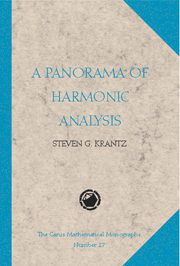Book contents
- Frontmatter
- Dedication
- Contents
- Preface
- 0 Overview of Measure Theory and Functional Analysis
- 1 Fourier Series Basics
- 2 The Fourier Transform
- 3 Multiple Fourier Series
- 4 Spherical Harmonics
- 5 Fractional Integrals, Singular Integrals, and Hardy Spaces
- 6 Modern Theories of Integral Operators
- 7 Wavelets
- 8 A Retrospective
- Appendices and Ancillary Material
- Appendix I The Existence of Testing Functions and Their Density in Lp
- Appendix II Schwartz Functions and the Fourier Transform
- Appendix III The Interpolation Theorems of Marcinkiewicz and Riesz-Thorin
- Appendix IV Hausdorff Measure and Surface Measure
- Appendix V Green's Theorem
- Appendix VI The Banach-Alaoglu Theorem
- Appendix VII Expressing an Integral in Terms of the Distribution Function
- Appendix VIII The Stone-Weierstrass Theorem
- Appendix IX Landau's O and o Notation
- Table of Notation
- Bibliography
- Index
Appendix III - The Interpolation Theorems of Marcinkiewicz and Riesz-Thorin
from Appendices and Ancillary Material
- Frontmatter
- Dedication
- Contents
- Preface
- 0 Overview of Measure Theory and Functional Analysis
- 1 Fourier Series Basics
- 2 The Fourier Transform
- 3 Multiple Fourier Series
- 4 Spherical Harmonics
- 5 Fractional Integrals, Singular Integrals, and Hardy Spaces
- 6 Modern Theories of Integral Operators
- 7 Wavelets
- 8 A Retrospective
- Appendices and Ancillary Material
- Appendix I The Existence of Testing Functions and Their Density in Lp
- Appendix II Schwartz Functions and the Fourier Transform
- Appendix III The Interpolation Theorems of Marcinkiewicz and Riesz-Thorin
- Appendix IV Hausdorff Measure and Surface Measure
- Appendix V Green's Theorem
- Appendix VI The Banach-Alaoglu Theorem
- Appendix VII Expressing an Integral in Terms of the Distribution Function
- Appendix VIII The Stone-Weierstrass Theorem
- Appendix IX Landau's O and o Notation
- Table of Notation
- Bibliography
- Index
Summary
The simplest example of an interpolation question is as follows. Suppose that the linear operator T is bounded on L1 and bounded on L2. Does it follow that T is bounded on Lp for 1 < p < 2? [The space Lp here is an instance of what is sometimes called an “intermediate space” between L1 and L2.] Note that this question is similar to (but not precisely the same as) one that we faced when considering the Lp boundedness of Calderón-Zygmund singular integral operators. Here we record (special) versions of the Riesz-Thorin Theorem (epitomizing the complex method of interpolation) and the Marcinkiewicz Interpolation Theorem (epitomizing the real method of interpolation) that are adequate for the applications in the present book.
Theorem (Riesz-Thorin):Let 1 ≤ p0 < p1 ≤ ∞. Let T be a linear operator on Lp0 ∩ Lp1 such that
and
If 0 ≤ t ≤ 1 and
then we have
Recall that, for 1 ≤ p < ∞, we say that a measurable function ƒ is weak-type p if there is a constant C > 0 such that, for every λ > 0,
We say that ƒ is weak-type ∞ if it is just L∞. A linear operator T is said to be of weak-type (p, p) if there is a constant C > 0 such that, for each ƒ ∈ Lp and each λ > 0,
An operator is weak-type ∞ if it is simply bounded on L∞ in the classical sense.
- Type
- Chapter
- Information
- A Panaroma of Harmonic Analysis , pp. 318 - 319Publisher: Mathematical Association of AmericaPrint publication year: 1999



